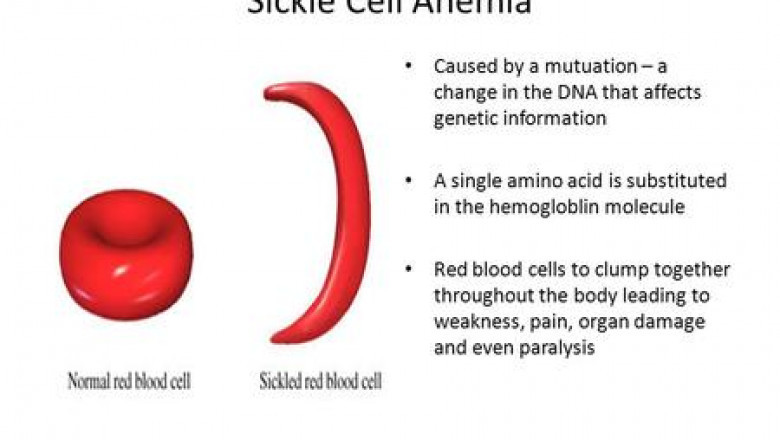views
Symptoms of Sickle Cell Anemia
Sickle cell anemia is a genetic blood disorder that affects red blood cells. The most common symptoms of sickle cell anemia include recurring episodes of pain, known as sickle cell crises. These pain crises most often occur in the bones and joints, as well as the abdomen, chest, and back. Other common symptoms include fatigue, shortness of breath, jaundice, frequent infections, and delayed growth and development in children. The symptoms of sickle cell anemia can range from mild to severe, depending on the individual.
Newborn Screening for Sickle Cell Anemia
In the United States and other developed countries, newborn screening for Sickle Cell Anemia Testing and Screening has been routine for decades. All babies typically have a blood sample taken shortly after birth, which is analyzed for abnormalities in hemoglobin as part of the newborn screening process. This blood sample is usually taken via a simple heel prick test. Newborn screening allows for early diagnosis and treatment of sickle cell anemia, before any symptoms appear. Early diagnosis and treatment can help prevent many serious health complications associated with the disease like infections, organ damage, and even death.
Testing Methods for Sickle Cell Anemia
There are a few different lab tests that can be used to screen for and diagnose sickle cell anemia:
- Hemoglobin electrophoresis: This test separates hemoglobin types based on their electric charge. It can identify abnormalities associated with sickle cell anemia and related conditions.
- High-performance liquid chromatography (HPLC): HPLC analyzes hemoglobin types based on chemical properties. It provides a precise measurement of abnormal hemoglobin levels.
- Isoelectric focusing (IEF): IEF separates hemoglobin by creating a pH gradient gel. The results show distinct bands for each hemoglobin type.
- Genetic testing: Testing can identify the precise genetic mutation causing sickle cell disease. This is important for family screening and counseling.
- Hemoglobin solubility testing: Abnormal hemoglobin from sickle cell anemia is less soluble than normal adult hemoglobin. This solubility-based test is used as a screening.
- Complete blood count (CBC): A CBC can show low red blood cell counts (anemia) and high white blood cell counts associated with sickle cell complications.
Carrier Screening and Genetic Counseling
Carrier screening is important for individuals whose family background or ethnicity indicates a higher risk of carrying the sickle cell gene. A simple blood test can determine carrier status. For those identified as carriers, genetic counseling provides information on inheritance risks and reproductive options like prenatal diagnosis. Partners of identified carriers should consider screening as well to determine if they are also carriers. If both partners are carriers, each pregnancy has a 25% chance of producing a child with sickle cell anemia. Genetic counseling helps expectant parents understand and prepare for this risk.
Management and Treatment of Sickle Cell Anemia
While there is no cure for sickle cell anemia, treatment focuses on managing symptoms and preventing complications. Daily medications, frequent doctor visits, vaccines, and penicillin during childhood all help reduce infection risks. Managing pain during episodes is key, with medications, hydration, heat or cold therapy, and sometimes blood transfusions. Hydroxyurea medication can help increase fetal hemoglobin levels and reduce symptoms for some. Bone marrow transplant from a matched sibling donor provides a potential cure, but is high-risk. For severe cases, chronic blood transfusions may be needed to prevent organ damage. Lifestyle factors like adequate rest, a healthy diet, exercise and avoiding dehydration can also help some manage their sickle cell disease. As research continues, new treatments are helping people with sickle cell anemia live longer, healthier lives.
The Role of Community Education and Advocacy
Raising awareness within at-risk communities is vital for addressing sickle cell disease on a broader public health level. Community organizations provide education on newborn screening, carrier and prenatal testing options available to families. They advocate for policy reforms and expanded insurance coverage to better support screening programs and management of this genetic disorder. Ending stigma is also important. With community support, more individuals are empowered to understand their carrier status or manage their disease through different stages of life. Overall, public awareness and engagement in sickle cell initiatives leads to healthier outcomes across affected populations.
Get this Report in Japanese Language:
Get this Report in Korean Language:
About Author:
Money Singh is a seasoned content writer with over four years of experience in the market research sector. Her expertise spans various industries, including food and beverages, biotechnology, chemical and materials, defense and aerospace, consumer goods, etc. (https://www.linkedin.com/in/money-singh-590844163)






















Comments
0 comment